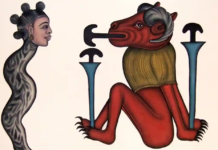For years I have tried to re-educate science students in my classes on the deeper matters of science: the philosophies of science. I have taught many to think about the influence a society can have on the search for deeper truths about our universe (nature). More I have taught students to consider the idea that who we are, what we are, and what we aspire to become, especially as a society has a huge impact on science. That is that science depends on the deeper truths about a society.
When a society is corrupt. The science will reflect the corruption. When the society is gluttonous the science will reflect that gluttony. When a society is barbaric the science will reflect that barbarism. When a society believes in intrinsic balance with nature, their science will reflect the inner workings of Ma’at.
Now, for illustrative measure, let us take for instance the science of Caucasian America (Kamericans) in the United States of America during the era of the barbaric enslavement of African Americans (Aamericans). It is no surprise that some of the worst science in human history was produced then: Most notably Phrenology and Craniology. So bizarre were these fields that any thinking human back then and now, with no bloody privilege whatsoever to gain from the barbarism of the enslavement of Blacks in America would gawk at the sheer nonsense of how any well-meaning human who is employed and funded at the University of Pennsylvania would indulge in attempting to predict human behavior (even human intelligence) through measurements of actual human skulls and even proceed as far as to delineate significant differences about those characteristics between Kamericans and Aamericans.
The motivation was straightforward: To feed Kamericans, whose gluttonous appetites rested solely on the violent inhumane enslavement of Africans on Kamerican-gluttony-producing and -maintaining plantations. The Kamerican scientists and their thoughts at the University of Pennsylvania for instance, and the Federal Funding they received, reflected the barbaric beliefs, the violent philosophies of the Caucasian colonizers of the Americas. The science of that period reflected the deeper truths about Kamericans who wanted to clutch at a rational for their barbarism. They needed to believe through their science that Aamericans were subhuman and that enslaving them only helped them. The Kamerican elite pushed Kamerican Science that espoused and furthered theories that buttressed the barbarism that was lodged at its socio-political core.
Concomitantly, compare the nature of science among the Gbe of West Africa during the same period. The nature of Gbe societies during this time was one contending with the plight of the terrorism of European pirates, who were funding the violence that generated slaves from West Africa to feed the Kamerican gluttony-producing-maintaining plantations in the United States in much the same way that today the West maintains the constant supply of slaves from Libya post the US invasion of Gaddafi’s nation. The Ewes, for example, developed a socio-political science (the Theory of Ayevu) to reveal the barbaric nature of the European terrorists. More the Ewes sought deeper meanings, or theories, of the universe they lived in. One such theory is the Agbodedefu (which literally translates as the “sending a ram into the sea”). The Ewes had formulated several socio-political technologies by which humans could live sustainably with the Oceans, especially when human life depended on harvesting food from oceans in which no human had sown a thing.
The difference between Kamerican society (Kamerican Science) and Ewe society (Ewe science) is significant. In one, Kamerican Science sought a gluttony-reproducing set of paradigms by any means necessary, while in the other, the Ewes sought paradigms that attempted to strike a balance with nature (Ma’at). The deeper truths of each society become obvious in the kind of theories and the kind of truths they sought.
In the twenty-first century, the story is no different. Kamerican Science exhibits the same penchant for gluttonous reproduction. For instance, in one century Kamerican Science pushed for mechanical automation for the production of junk (sugar, guns, atomic bombs and alcohol) when it became clear that Phrenology, Craniology and other Race Sciences were inherently inconsistent. There were many Aamericans with the “wrong skull sizes” who were way stronger, smarter, brighter and more intelligent than Kamericans with all the “right skull sizes”.
When the internal contradictions of Kamerican Sciences intensified, Kamerican Science did not change. Rather it metamorphosed into an even more clandestine science. Slave labor gave way (although not entirely) to the mechanical production of gluttony. And so on. When mechanical production was shown to be destroying the planet, Kamerican Science posited that the world invest in more and more gluttonous production by way of more digital production: More solar panels, more batteries, more battery powered cars, more solar homes, more LEDs, more tiny homes, more this and more that so long as more of something else had to be produced. There was no room to halt the production of more stuff.
The science always reflecting the deeper truths about its practitioners: Gluttony. At no point does Kamerican scientific theories reflect restraint or balance (Ma’at) with nature. At no point does Kamerican Science posit theories of producing and reproducing less junk. It is as if the idea of restraint is not a deeply Kamerican one. Kamerican or European Science continues to reproduce in Kamerican and Caucasian societies (which make up only five percent of the world’s population) the gluttonous need to consume (reap) year in and year out over sixty-percent of the world’s resources (that which they had not sown) and produce more than sixty percent of the world’s waste in return.
To appreciate the alarming dependence of science on the deeper truths of the society that practices it, one needs only examine the fields of science in the gluttonous United States today. Not a day passes by without a study praising a new drug for some old or better, new ailment. Not a day passes by without a study claiming a vaccine was “well tolerated” by infants. Not a day passes by without a study claiming GMOs are perfectly safe. Not a day passes by without a study reporting the mass production of more stuff somewhere else to stem the dire effects of man-made global warming. The Kamerican scientists kiss their theories and they try to make them sound even better.
Recently some Kamerican science editors have begun to call out their beloved scientists. Richard Horton, editor-in-chief, The Lancet, in The Lancet, 11 April, 2015, Vol 385, “Offline: What is medicine’s 5 sigma?” wrote that: “The case against [Kamerican] science is straightforward: much of the [Kamerican] scientific literature, perhaps half, may simply be untrue. Afflicted by studies with small sample sizes, tiny effects, invalid exploratory analyses, and flagrant conflicts of interest, together with an obsession for pursuing fashionable trends of dubious importance, science has taken a turn towards darkness. …The apparent endemicity of bad research behaviour is alarming. In their quest for telling a compelling story, [Kamerican] scientists too often sculpt data to fit their preferred theory of the world. Or they retrofit hypotheses to fit their data. Journal editors deserve their fair share of criticism too. We aid and abet the worst behaviours. Our acquiescence to the impact factor fuels an unhealthy competition to win a place in a select few journals. Our love of ‘significance’ pollutes the literature with many a statistical fairy-tale…Journals are not the only miscreants. Universities are in a perpetual struggle for money and talent…”
More, Marcia Angell, former editor of The New England Journal of Medicine, in the NY Review of Books, January 15, 2009, “Drug Companies & Doctors: A Story of Corruption” wrote that: “It is simply no longer possible to believe much of the [Kamerican] clinical research that is published, or to rely on the judgment of trusted physicians or authoritative medical guidelines. I take no pleasure in this conclusion, which I reached slowly and reluctantly over my two decades as an editor of The New England Journal of Medicine.”
Also, John PA Ioannidis, Department of Hygiene and Epidemiology, University of Ioannina School of Medicine, Ioannina, Greece, and Institute for Clinical Research and Health Policy Studies, Department of Medicine, Tufts-New England Medical Center, Tufts University School of Medicine, Boston, Massachusetts, in PLoS Medicine, August 30, 2005, in “Why Most Published Research Findings Are False” wrote that: “There is increasing concern that most current published research findings [in all scientific fields] are false… a research finding is less likely to be true when the studies conducted in a field are smaller; when effect sizes are smaller…when there is greater financial and other interest and prejudice; and when more teams are involved in a scientific field in chase of statistical significance. Simulations show that for most study designs and settings, it is more likely for a research claim to be false than true. Moreover, for many current scientific fields, claimed research findings may often be simply accurate measures of the prevailing bias…There is increasing concern that in modern research, false findings may be the majority or even the vast majority of published research claims. However, this should not be surprising. It can be proven that most claimed research findings are false.”
And finally, back to Richard Horton, editor-in-chief of The Lancet. In the same editorial quoted above, Horton makes reference to a recent symposium he attended at the Wellcome Trust in London. The subject of the meeting was the reliability of published biomedical research. His following quote carries additional force about the nature of science in a corrupt and gluttonous society because he and other attendees were told to obey Chatham House rules—meaning no one would reveal who made any given comment during the conference. Horton wrote that one commentator at the conference said: “A lot of what is published is incorrect.”
He went on to say that: “I’m not allowed to say who made this remark because we were asked to observe Chatham House rules. We were also asked not to take photographs of slides. Those who worked for government agencies pleaded that their comments especially remain unquoted, since the forthcoming UK election meant they were living in ‘purdah’—a chilling state where severe restrictions on freedom of speech are placed on anyone on the government’s payroll. Why the paranoid concern for secrecy and non-attribution? Because this symposium—on the reproducibility and reliability of biomedical research, held at the Wellcome Trust in London last week—touched on one of the most sensitive issues in science today: the idea that something has gone fundamentally wrong with one of our greatest human creations [biomedical science].”
What Horton does not comprehend fully, or what he refuses to show the world, is that nothing “has gone fundamentally wrong with” Kamerican Science per se. Instead, Kamerican Science has always morphed in clandestine ways, from one decade to the next, from one century to the next, to conceal the inherent philosophy that guides its practice: Gluttony, by any means. Science has never been objective and it will remain a subject dependent on the whims and caprices of the society that informs the erection of its pillars. Unfortunately, in a world becoming increasingly barbaric as a result of the last three centuries of Western global dominance, only one final state seems possible: Kamerican Science, and with it, the total demise of the very planet that our African Ancestors have managed to preserve for over hundreds of thousands of years. The true philosophical foundation of Western Science is Gluttony and its true intent is to destroy mankind and the planet.










